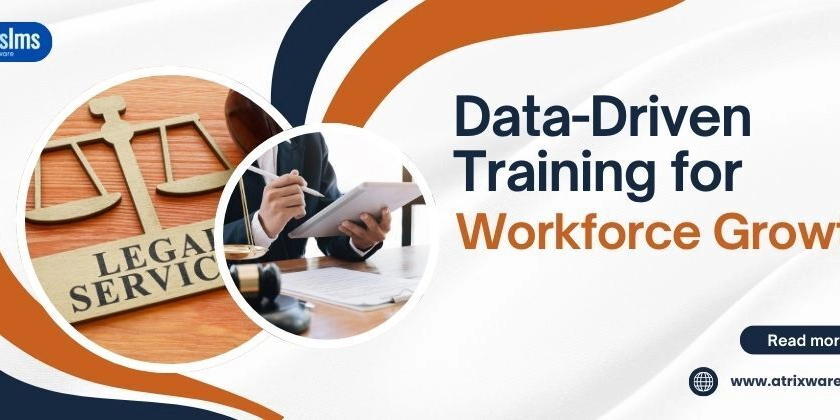Data-Driven Training Strategies: Leveraging Software for Workforce Growth
In today’s rapidly evolving business world, staying ahead requires more than innovation—it demands a workforce that’s continuously learning and adapting. Traditional training programs, while once effective, often fall short in addressing the diverse needs of modern employees. These outdated models lack flexibility, fail to provide personalized learning, and are rarely data-informed. As a result, organizations are turning to data-driven training strategies that blend technology, analytics, and real-time insights to transform how learning is delivered and measured. Why Data-Driven Training Matters Rather than applying a uniform approach to all learners, data-driven training leverages employee performance metrics, behavioral data, and predictive algorithms to build individualized development paths. Supported by technologies such as artificial intelligence (AI), machine learning (ML), and intelligent analytics tools, this approach allows businesses to align training initiatives with both employee needs and organizational objectives. A core advantage of this shift lies in the seamless integration of platforms—such as Learning Management Systems (LMS), Learning Experience Platforms (LXP), and Learning Record Stores (LRS)—which work together to provide a comprehensive view of learner progress and outcomes. These insights empower leaders to adapt training strategies in real time and make informed, evidence-based decisions. The Strategic Benefits of Data-Informed Learning 1. Customized Learning Journeys AI-enabled tools evaluate each employee’s current skill set, job performance, and learning behavior to recommend content that is highly relevant and targeted. This not only enhances learner engagement but also minimizes time spent on irrelevant material, improving learning efficiency across the board. 2. Real-Time Insight into Learner Performance Modern LMS platforms feature interactive dashboards and reporting tools that provide detailed data on user activity. Organizations can monitor learner progress, course completions, knowledge retention, and engagement patterns—enabling timely support or intervention when necessary. 3. Forecasting Future Learning Needs With the help of predictive analytics, companies can identify skill shortages before they become critical. By analyzing trends in workforce data, organizations can proactively launch upskilling or reskilling programs aligned with anticipated business changes or technological advancements. 4. Measurable Impact and ROI Using analytics, HR and L&D teams can correlate learning outcomes with business KPIs such as productivity, retention, or revenue growth. This creates a feedback loop that continuously refines training programs and justifies investment in learning technologies. 5. Dynamic, On-Demand Learning Models Machine learning capabilities allow training content to adapt based on how individuals perform or interact with materials. As a result, learning becomes an ongoing, personalized experience that evolves with each user. Enhancing Growth Through Smart Training Technologies To keep pace with today’s business demands, organizations are integrating intelligent tools and platforms that scale effectively while ensuring quality learning outcomes. Key components of a modern training ecosystem include: AI-Driven Adaptive Platforms These systems personalize the learning experience by adjusting the content format, difficulty, and pacing to suit the learner’s progress. For example, technical employees may engage with hands-on simulations, while customer-facing staff may benefit more from real-world scenario modules. Learning Record Stores (LRS) LRS technology allows the tracking of learning across multiple systems—not just the LMS. This includes informal activities such as mobile learning, peer collaboration, and on-the-job practice, offering a more holistic view of employee development. Microlearning & Contextual Delivery Short, targeted learning modules are ideal for busy employees. When paired with just-in-time delivery—such as mobile prompts or chatbot guidance—they enable quick knowledge access and practical application right in the flow of work. Gamification and Interactive Learning Tools Game-based elements like quizzes, achievements, and simulated environments enhance participation and knowledge retention. Interactive formats foster active learning and improve confidence through experiential practice. Competency-Based Frameworks Aligning training with clearly defined role-based competencies ensures that development is strategic. This alignment supports talent mobility and helps employees visualize their path to advancement within the company. Advanced Employee Training Management Software Implementing a robust employee training management software system is crucial for streamlining training operations. These platforms go beyond basic LMS functions by automating sche

In today’s rapidly evolving business world, staying ahead requires more than innovation—it demands a workforce that’s continuously learning and adapting. Traditional training programs, while once effective, often fall short in addressing the diverse needs of modern employees. These outdated models lack flexibility, fail to provide personalized learning, and are rarely data-informed. As a result, organizations are turning to data-driven training strategies that blend technology, analytics, and real-time insights to transform how learning is delivered and measured.
Why Data-Driven Training Matters
Rather than applying a uniform approach to all learners, data-driven training leverages employee performance metrics, behavioral data, and predictive algorithms to build individualized development paths. Supported by technologies such as artificial intelligence (AI), machine learning (ML), and intelligent analytics tools, this approach allows businesses to align training initiatives with both employee needs and organizational objectives.
A core advantage of this shift lies in the seamless integration of platforms—such as Learning Management Systems (LMS), Learning Experience Platforms (LXP), and Learning Record Stores (LRS)—which work together to provide a comprehensive view of learner progress and outcomes. These insights empower leaders to adapt training strategies in real time and make informed, evidence-based decisions.
The Strategic Benefits of Data-Informed Learning
1. Customized Learning Journeys
AI-enabled tools evaluate each employee’s current skill set, job performance, and learning behavior to recommend content that is highly relevant and targeted. This not only enhances learner engagement but also minimizes time spent on irrelevant material, improving learning efficiency across the board.
2. Real-Time Insight into Learner Performance
Modern LMS platforms feature interactive dashboards and reporting tools that provide detailed data on user activity. Organizations can monitor learner progress, course completions, knowledge retention, and engagement patterns—enabling timely support or intervention when necessary.
3. Forecasting Future Learning Needs
With the help of predictive analytics, companies can identify skill shortages before they become critical. By analyzing trends in workforce data, organizations can proactively launch upskilling or reskilling programs aligned with anticipated business changes or technological advancements.
4. Measurable Impact and ROI
Using analytics, HR and L&D teams can correlate learning outcomes with business KPIs such as productivity, retention, or revenue growth. This creates a feedback loop that continuously refines training programs and justifies investment in learning technologies.
5. Dynamic, On-Demand Learning Models
Machine learning capabilities allow training content to adapt based on how individuals perform or interact with materials. As a result, learning becomes an ongoing, personalized experience that evolves with each user.
Enhancing Growth Through Smart Training Technologies
To keep pace with today’s business demands, organizations are integrating intelligent tools and platforms that scale effectively while ensuring quality learning outcomes. Key components of a modern training ecosystem include:
AI-Driven Adaptive Platforms
These systems personalize the learning experience by adjusting the content format, difficulty, and pacing to suit the learner’s progress. For example, technical employees may engage with hands-on simulations, while customer-facing staff may benefit more from real-world scenario modules.Learning Record Stores (LRS)
LRS technology allows the tracking of learning across multiple systems—not just the LMS. This includes informal activities such as mobile learning, peer collaboration, and on-the-job practice, offering a more holistic view of employee development.Microlearning & Contextual Delivery
Short, targeted learning modules are ideal for busy employees. When paired with just-in-time delivery—such as mobile prompts or chatbot guidance—they enable quick knowledge access and practical application right in the flow of work.Gamification and Interactive Learning Tools
Game-based elements like quizzes, achievements, and simulated environments enhance participation and knowledge retention. Interactive formats foster active learning and improve confidence through experiential practice.Competency-Based Frameworks
Aligning training with clearly defined role-based competencies ensures that development is strategic. This alignment supports talent mobility and helps employees visualize their path to advancement within the company.Advanced Employee Training Management Software
Implementing a robust employee training management software system is crucial for streamlining training operations. These platforms go beyond basic LMS functions by automating scheduling, tracking compliance, and offering advanced analytics for workforce-wide learning insights. They allow L&D teams to manage multiple programs across regions and departments with ease and precision.
Overcoming Implementation Challenges
Although data-driven training offers significant advantages, it also introduces complexity. Common challenges include:
Integrating Disparate Data Sources: Many organizations operate with disconnected systems. Choosing platforms that support interoperability standards like xAPI or SCORM helps unify data collection.
Driving Cultural Change: Shifting toward a data-informed approach often requires internal buy-in. It’s essential to train managers and leaders on how to use analytics effectively.
Maintaining Data Ethics: Ensuring compliance with regulations (e.g., GDPR) and using learner data responsibly is critical to preserving employee trust and avoiding legal risks.
Preparing for the Future of Learning
As digital transformation reshapes industries, forward-thinking companies are expanding the scope of learning beyond internal teams. Many now use LMS for customer training, providing clients, partners, and vendors with tailored onboarding, product knowledge, and compliance modules. These external training initiatives help increase product adoption, improve user experience, and strengthen customer loyalty—further proving the strategic value of modern learning technologies.
Looking ahead, businesses that invest in intelligent learning ecosystems today are building more than capability—they’re creating future-ready teams. By embedding analytics, automation, and personalization into training strategies, organizations not only enhance performance but also foster a culture of continuous learning and innovation.











































































![[Sponsor] Dekáf Coffee Roasters](https://dekaf.com/cdn/shop/files/DEKAF_LOGO.png?v=1745515850)
